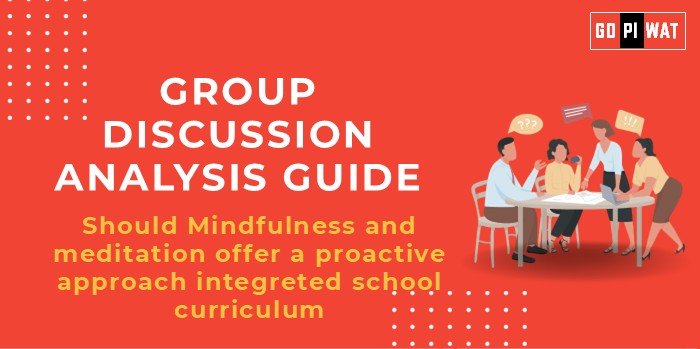📋 Group Discussion Analysis Guide
🌐 Introduction to the Topic
Opening Context: In an era of increasing academic pressures and mental health challenges, integrating mindfulness and meditation into school curriculums has emerged as a potential solution to enhance students’ overall well-being and learning abilities. This discussion gains relevance as educational institutions worldwide explore holistic approaches to student development.
Topic Background: Mindfulness and meditation are ancient practices with origins in Buddhist traditions, now widely adopted for stress management, emotional regulation, and cognitive improvement. Over the past decade, schools in countries like the UK, USA, and Australia have begun experimenting with such practices, citing benefits for mental health and academic performance.
📊 Quick Facts and Key Statistics
- Mental Health Crisis: 10-20% of children globally experience mental health disorders (WHO), underscoring the need for preventive strategies.
- Academic Stress in India: 86% of students aged 12-18 report stress due to exams (NIEPA, 2023).
- Mindfulness Programs: Schools with meditation programs report a 28% decrease in disruptive behavior (American Psychological Association).
- Global Adoption: Over 4,000 schools in the UK have introduced mindfulness as part of their curriculum (Mindfulness in Schools Project, 2022).
🧑🤝🧑 Stakeholders and Their Roles
- Educational Institutions: Implement mindfulness programs, train educators, and evaluate outcomes.
- Governments and Policy Makers: Provide funding, guidelines, and frameworks for curriculum integration.
- Parents and Guardians: Support and reinforce mindfulness practices at home.
- Mental Health Experts: Design effective, age-appropriate mindfulness modules.
- Students: Primary beneficiaries, developing improved focus and emotional resilience.
📈 Achievements and Challenges
Achievements
- Improved Mental Health: Studies link mindfulness to a 30% reduction in stress-related symptoms in adolescents.
- Enhanced Academic Performance: Schools implementing meditation observe up to a 15% improvement in student test scores.
- Social Skills Development: Mindfulness enhances empathy and reduces bullying incidents.
Challenges
- Resistance to Change: Traditional education systems may resist adopting non-academic practices.
- Lack of Resources: Insufficient funding and trained staff hinder implementation.
- Cultural Sensitivity: Misinterpretation as a religious practice may deter stakeholders.
Global Comparisons:
- USA: Mindfulness-based programs like “MindUP” show reduced aggression in students.
- Finland: Known for its holistic education, mindfulness is seamlessly integrated into daily routines.
Case Studies: Delhi’s “Happiness Curriculum” includes mindfulness, showing positive feedback from students and teachers.
📂 Structured Arguments for Discussion
- Supporting Stance: “Mindfulness equips students with life skills to manage stress, enhancing both academic and personal growth.”
- Opposing Stance: “Prioritizing mindfulness over traditional academics may dilute focus on core educational goals.”
- Balanced Perspective: “Mindfulness should complement, not replace, academic subjects, offering a balanced approach to education.”
✨ Effective Discussion Approaches
- Opening Approaches:
- Statistic-based: “With 20% of global children affected by mental health issues, is education without mindfulness truly comprehensive?”
- Case Study Opening: “Delhi’s Happiness Curriculum highlights how mindfulness can transform student well-being.”
- Counter-Argument Handling:
- Emphasize that mindfulness enhances cognitive functions, indirectly benefiting academics.
- Highlight global success stories to address resistance to change.
🔍 Strategic Analysis of Strengths and Weaknesses
- Strengths: Proven mental health benefits, low-cost implementation.
- Weaknesses: Limited awareness and training.
- Opportunities: Integration with digital tools like meditation apps.
- Threats: Misconceptions about religious affiliations.
📚 Connecting with B-School Applications
- Real-World Applications: Framework for incorporating wellness in workplace strategies.
- Sample Interview Questions:
- “How can mindfulness practices enhance leadership qualities?”
- “Evaluate the economic implications of reduced stress levels in the workforce.”
- Insights for B-School Students:
- Learn to balance productivity with mental well-being.
- Explore research in behavioral economics and wellness.


